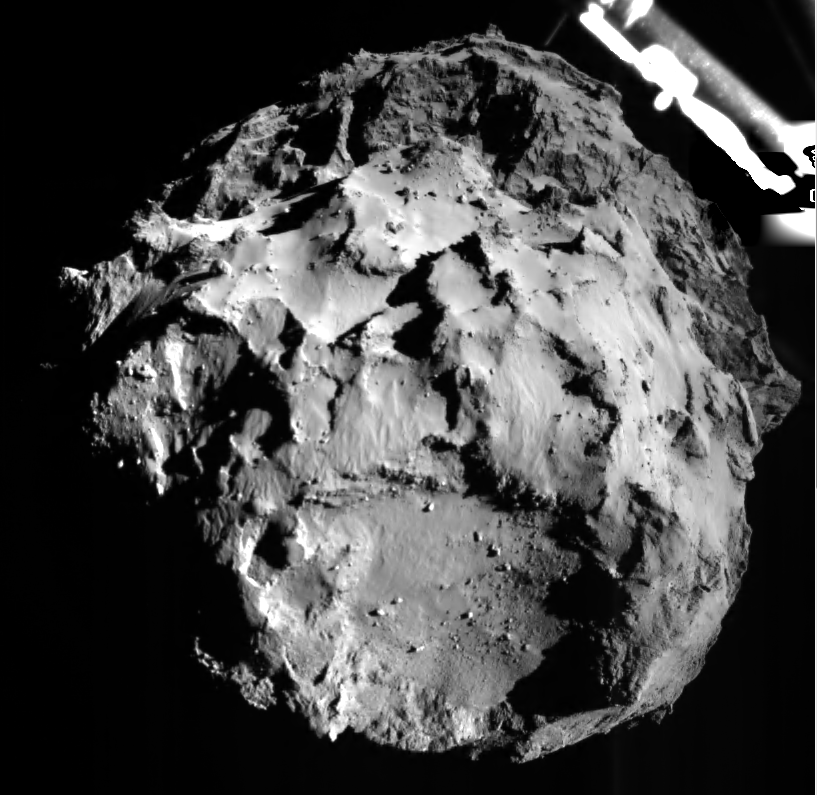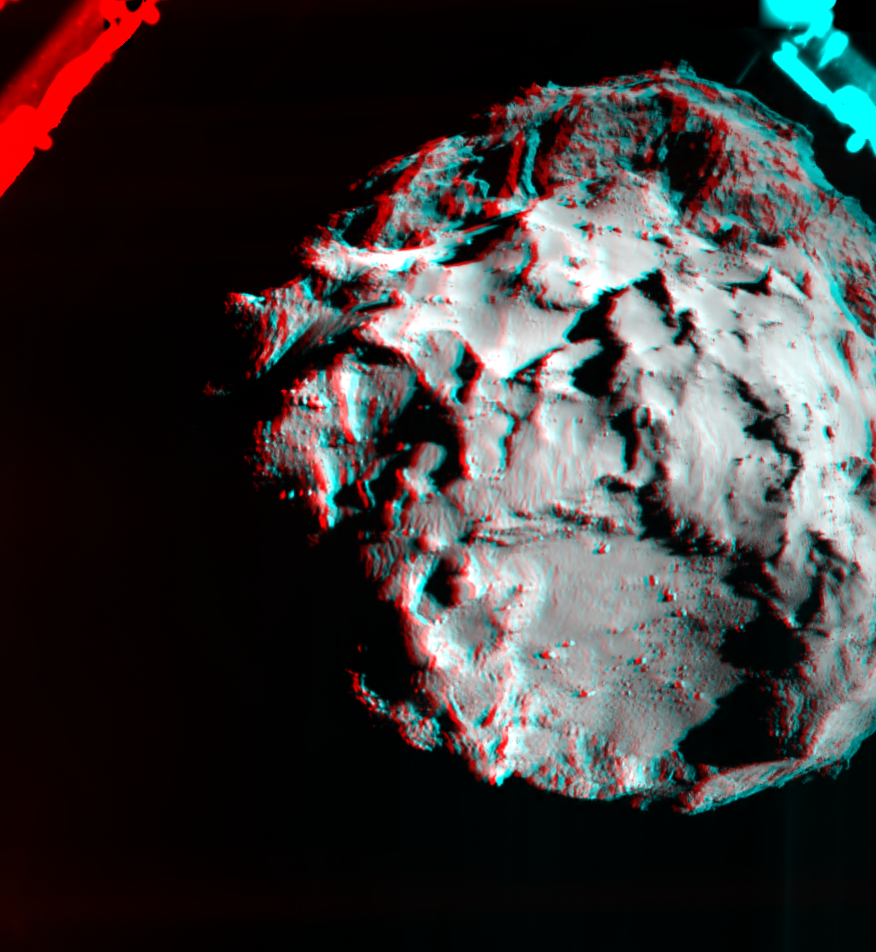
By combining tantalizing clues from several different science instruments, the Rosetta science team is homing in on the location of Europe’s plucky Philae lander’s final landing site after successfully completing history’s first-ever soft landing on a comet, nearly two weeks ago, and discovering organic molecules.
Following a precision deployment from the European Space Agency’s (ESA) Rosetta orbiter for the nail-biting, uncontrolled, seven-hour-long descent to the surface on Nov. 12, the Philae robotic probe finally came to rest on the distant comet—but only after a harrowing journey that unexpectedly included two rebounds back into space from its initially targeted touchdown zone at a spot named “Agilkia.”
Philae not only survived but also accomplished breathtaking science by detecting organic molecules—the building blocks of life—on the surface of comet 67P/Churyumov–Gerasimenko following the safe and history-making touchdown.
Altogether, Philae landed three times before finally stopping beside a heavily shadowed cliffside spot on the dust covered, icy surface of comet 67P.
Comet 67P measures only 4 kilometers (2.5 mile) wide. Philae was targeted to land on the “head” of the bizarre two-lobed comet while it was rotating once about every 12.4 hours.
The refrigerator-sized Philae probe not only landed undamaged but successfully completed its primary science mission.
The 100-kg (220-lb) Philae is a mini laboratory equipped with 10 state-of-the-art science instruments that photographed, sniffed the atmosphere, drilled, hammered, and studied Comet 67P/ Churyumov-Gerasimenko in detail during the mission’s Primary Science Phase.

It was controlled and monitored from the DLR (Deutsche Luft und Raumfahrt or German Space Agency), which heads the consortium funding the lander.
Since that historic touchdown day, researchers have been trying to find Philae!
The primary instruments aiding the search for Philae’s final landing site are OSIRIS, NAVCAM, and CONSERT.
Scientists and engineers have conducted an ongoing visual search by combing through high-resolution OSIRIS and NAVCAM images streaming back from the Rosetta orbiter, as well as examining radio signals from the CONSERT experiment.
CONSERT is the Comet Nucleus Sounding Experiment by Radio wave Transmission instrument and is being used to help identify the location of the lander through an experiment that works between the Rosetta orbiter and the Philae lander.
“It works by transmitting radio signals from the orbiter to the lander, and when the geometry is right, the signals pass through the nucleus of the comet, allowing its interior to be analysed,” according to an ESA statement.
“The signals are received on the lander, where some data is extracted, and then immediately a new signal is transmitted back to the orbiter, where the main experimental data collection occurs. As the radio waves pass through different parts of the cometary nucleus, variations in propagation time and amplitude occur, and these can be used to determine various properties of the internal material and carry out a form of ‘tomography’.”
With the radio signal measurements obtained so far, the team has narrowed down the search zone to the areas in the lead image. The team is analyzing measurements made through the comet’s core during periods of direct visibility between the two spacecraft.
“The determination of the landing zone is dependent on the underlying comet shape model used, which is why there are two candidate regions marked.”

By refining the imagery and radio measurements, the team can better predict Philae’s location.
“The CONSERT team also needs to know where Philae is before they can fully analyze their scientific data.”
Unfortunately, when Philae finally stopped hopping around it came to rest in a rather shady spot next to a tall cliff that blocked most of the sunlight from reaching the solar panels, thus severely limiting its ability to generate new power from the life-giving solar arrays and sustain ongoing operations.
Nevertheless, Philae successfully transmitted unprecedented science measurements and data for some 60 hours after surviving the unplanned triple touchdown on battery power alone, before finally entering hibernation mode on Nov. 15, due to insufficient sunlight impinging on the power generating solar arrays.

“It has been a huge success, the whole team is delighted,” said Stephan Ulamec, lander manager at the DLR German Aerospace Agency, who monitored Philae’s progress from ESA’s Space Operations Centre in Darmstadt, Germany, all this week.
“Despite the unplanned series of three touchdowns, all of our instruments could be operated and now it’s time to see what we’ve got. Prior to falling silent, the lander was able to transmit all science data gathered during the First Science Sequence.”
“This machine performed magnificently under tough conditions, and we can be fully proud of the incredible scientific success Philae has delivered.”
Philae’s last transmission was received via the Rosetta mothership at 01:36 a.m. CET Nov. 15/7:36 p.m. EST Nov. 14.
Philae journeyed piggybacked on the Rosetta mothership during a gutsy 10-year interplanetary trek through space while traveling some 500 million kilometers (300 million miles) from Earth at 41,000 mph on a mission of cutting-edge science to elucidate our origins.

The Rosetta mission seeks to answer or at least inform us about this question: Did comets play a role in the origin of life on Earth?
Comets are the pristine leftover remnants from the formation of our Solar System some 4.5 billion years ago.
Therefore, comets could hold clues to the origin of life on Earth since they brought significant quantities of water and organic molecules to the early Earth as it was evolving.
Stay tuned here for continuing developments.
Want to keep up-to-date with all things space? Be sure to “Like” AmericaSpace on Facebook and follow us on Twitter: @AmericaSpace






Ken: Your articles on such an historic technical and scientific achievement are providing the average reader with such rich detail. We are in the midst of enormous discoveries and you are providing us with an important accounting of mankind’s endeavor to understand the cosmos. Thank you.
Thanks Tom! glad you enjoy my articles here!